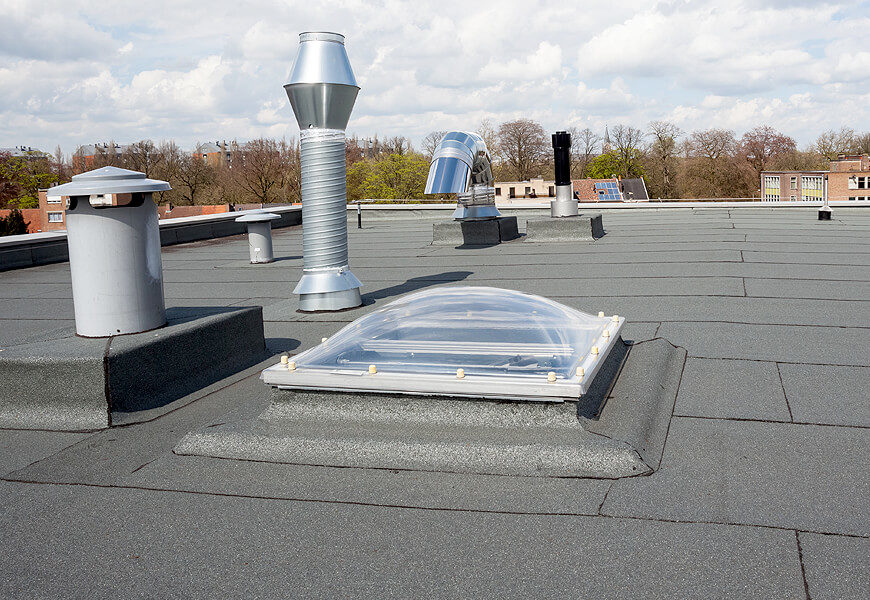
The greatest roof ventilation systems not only increase the life of your roof, but they also assist in cutting your energy bills and make your home a healthier place to live in general. When it comes to flat roof vents, you have various options. Some of these vents are extremely simple, while others have some decorative flare. Most importantly, a roof with insufficient ventilation will have a limited life and make the residents unhappy. Without ventilation, the roof is vulnerable to severe temperatures, which will cause damage over time. Always call a professional roofer to fit in the flat roof vents.
Exhaust
Allowing heated air to stagnate can lead to bad-smelling mildew and, eventually, mold. As previously said, this is one of the primary reasons ventilations is critical to the health of your home. Because hot air rises, exhaust-style vents are typically installed at the top of your roof. The ridge vent is the most frequent type of exhaust vent utilized in contemporary roofing systems.
Intake
Hot air exiting your attic is crucial for the health of your house and the durability of your roof, yet hot air is notoriously difficult to remove! It won't leave until it's pushed to. Therefore, we'll need something to act as a bouncer. Cooler air enters the picture. The second part of a strong venting technique is cool, fresh air (intake ventilation). Cooler air enters your attic space through intake vents located lower on the roof line than the exhaust vents indicated above. Because cooler air enters beneath hot air (and hot air rises), intake ventilation will assist in pushing the recalcitrant hot air out of the attic space. Cool air is drawn in by intake-type vents (similar to a soffit) and functions as a bouncer.
As long as you have exhaust vents with a large enough surface area, the cooler intake air will assist in pushing the hot air out of the house.
Roofing vents are classified into two types: natural and mechanical.
Natural vents circulate air in and out of the roof using natural air movement and thermodynamic factors. Mechanical vents, on the other hand, require power to provide mechanical airflow and ventilation. Both approaches are used to generate airflow within a roof. However, whether or not these methods require power, there is a significant difference. Both natural and mechanical vents have advantages and disadvantages, and you must choose which is best suited to your property. Mechanical vents are more efficient, but they are more expensive, can be loud, and have continuing requirements such as energy. Natural vents are quiet and cost-effective, but they are inefficient and require more vents to produce the same amount of air, which isn't always aesthetically pleasing.
Let's take a closer look at some of the more particular flat roof venting solutions from these two groups. The following are the primary venting options:
A pop vent, also known as a louver pop vent, is a mechanical vent that creates airflow with an electric fan. A pop vent is a popular choice for homes with flat roofs because of its capacity to bring in fresh external air from the outside or remove heated interior air from the roof cavity.
Aura vents can be mechanical or natural (it has no moving parts, giving them a long life). It is known as an aura gravity roof vent as a natural vent that dynamically eliminates heat when it is hot and moisture when it is cold. The mechanical version is identical to the exterior, but it has an internal fan that forces heated air out and draws fresh air into the roof.
A boot vent is a simple device that consists of pipes installed through the roof and a rubber boot to prevent leaks. Due to its popularity and ease of use, you may have issues as the rubber begins to fracture and decay, which can occur over time.
Another basic vent is a box vent. The vent, which resembles a box, requires adequate circulation to force air out of the roof. This implies that they are more effective on flat or low-pitch roofs. They are, however, often tiny in size, and property may require additional box vents to provide enough ventilation.
Soffit vents are intake vents that deliver cold, fresh air to the roof. If the box, mushroom, or boot vents are utilized on a flat roof, soffit vents are an excellent complement to the ventilation system since they help to push hot air out naturally with cold air.
Breathing vents are excellent for removing moisture from flat roofs. They employ a bellow that opens and shuts in response to moisture levels. Because of the low pitch of flat roofs, moisture and air cannot always travel easily between various roof portions; hence, some breather vents are suitable for appropriately expelling moisture.
A mushroom vent is a basic natural vent that may or may not be suitable for a flat roof since it relies on the pitch to release hot air and an intake vent to pull in the fresh air. As a result, mushroom vents are not a viable flat roof venting solution unless you have soffit vents or mechanical intakes.
This style of bathroom vent is designed to manage a considerable volume of steam and moisture. It must be mechanical to manage the high volume of steam, and it lends itself to a flat roof since it may be installed right above the bathroom ceiling.
This style of vent is perfect for connecting the roof joists. This can be used in an exceptionally flat installation with an incorporated cant that allows for water drainage. The cant vent can be used in a vertical position as well.
Contact our skilled roofers to inquire about or install a flat roof vent at 1274 5th Ave New York, NY 10029 (212) 457-1324 https://bestroofingnyc.com